How CEC is using RAPIDS funding to strengthen education excellence
Regionally Aligned Priorities in Delivering Skills (RAPIDS) grants have empowered CEC to purchase state-of-the-art equipment for use in learning laboratories.
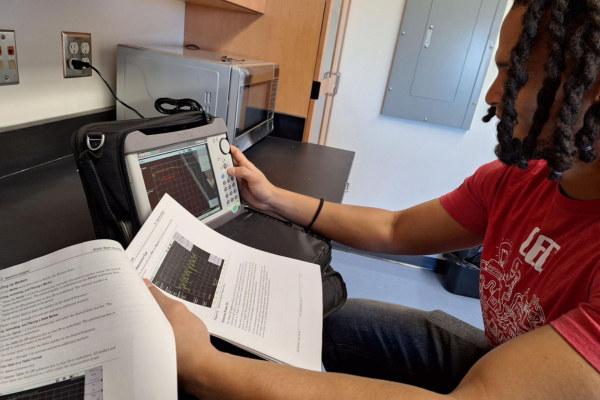
How CEC is using RAPIDS funding to strengthen education excellence
Over the past few years, Miami University’s College of Engineering and Computing (CEC) faculty and staff have strengthened student learning and technical training with support from the Ohio Department of Higher Education’s RAPIDS grant program .
Regionally Aligned Priorities in Delivering Skills (RAPIDS) grants from the Ohio Department of Higher Education are designed to strategically support regional workforce development in growing industries. Funding provided through RAPIDS at CEC has allowed leadership to purchase state-of-the art equipment that students can use for learning, research, and projects – all with the aim of training the next generation of engineering and computing talent.
The RAPIDS grant funding initiative has been going on for years, and throughout its history CEC has been active in leveraging its support to amplify student offerings. Below, you can explore some of the technology and equipment purchased through RAPIDS funding, and how it has benefited the CEC student experience in preparing graduates for a rapidly changing workforce.
FANUC Industrial Robots
UR 5 Robots with Pneumatic Workcell
Miami University’s Department of Mechanical and Manufacturing Engineering used RAPIDS 2 funding to secure a set of UR 5 Robots with Pneumatic Workcell. Since the department’s purchase in 2018, hundreds of students have been trained using this equipment. Courses which utilize this technology include MME 305 (Measurements and Instrumentation), MME 437 (Manufacturing Automation), and MME 448 (Senior Design Capstone). The UR 5 Robots with Pneumatic Workcell equipment has also been instrumental in the Systems Automation Springboard to Internships (SASI) pre-internship program which has occurred each Winter Term since 2021.
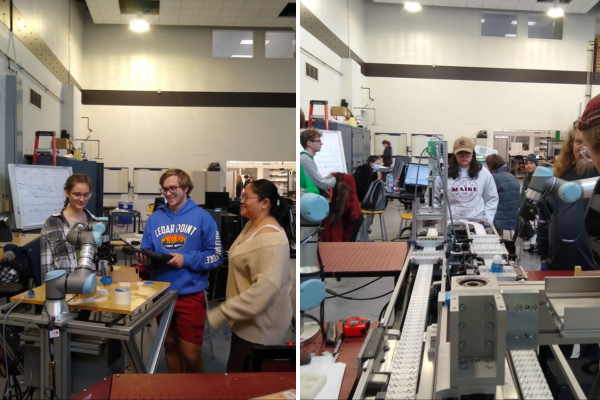
Having the UR 5 Robots with Pneumatic Workcell on hand for the SASI program has been a powerful professional tool for CEC students. The SASI program was developed in collaboration with industry, and sponsoring companies like Westrock, Greif, Valmet, and Paper Corporation of America have leveraged the equipment to provide a 3-week intensive hands-on training program in process control and automation that prepares students directly for work with industry.
Dell PowerVault SAN (Storage Area Network)
Using SuperRAPIDS funding, Miami University’s Department of Computer Science and Software Engineering purchased a Storage Area Network (SAN) for use in Miami’s Cybersecurity Lab. The storage array component of the SAN is especially valuable to cybersecurity and other computer science and software engineering students because it enables them to have the opportunity to practice configuring and protecting servers through Red Team and Blue Team exercises, as well as through undergraduate and graduate level research alongside faculty members like James Walden, Director of the Center for Cybersecurity.
In Red Team and Blue Team exercises, one team of students configures and protects servers, while the other team endeavors to attack those servers. These exercises aim to simulate real-world attacks on university systems, supporting students’ efforts in attempting to find vulnerabilities or extract information from defensive systems. Learnings from exercises like these, available through the infrastructure technology provided by the Storage Area Network purchased through SuperRAPIDS funding, allow students to learn critical security skills for their future careers.
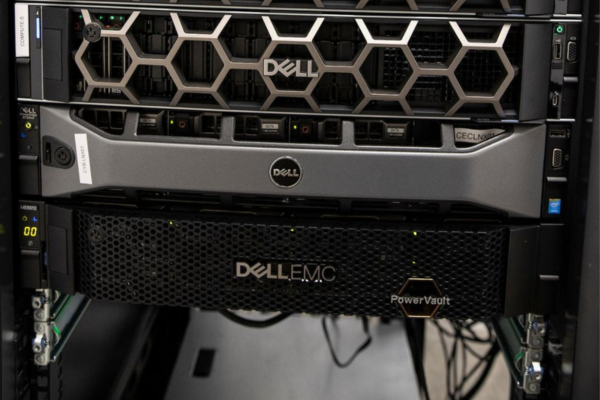
Quanser QCar
The Quanser QCar, acquired through RAPIDS funding by the Department of Electrical and Computer Engineering , is an open-architecture, scaled model vehicle designed for academic teaching and research. A sensor-rich autonomous vehicle for self-driving applications, the QCar is equipped with a wide range of sensors including LIDAR, 360-degree vision, depth sensor, IMU, and encoders. Since its purchase by the department, the QCar has been used for research and capstone design projects by Miami students at CEC who are interested in autonomous vehicle technology.

Anritsu’s Site Master and PIM Master Passive Intermodulation Analyzer
Miami University’s Department of Electrical and Computer Engineering (ECE) strengthens Miami University’s role as part of the Southwest Ohio 5G Node – a regional hub designed to support the implementation of Ohio's Broadband and 5G Workforce Strategy locally. As part of this leadership role, Miami’s ECE department offers technical elective courses based on the Wireless Infrastructure Association (WIA)’s 5G readiness program . Anritsu’s Site Master and PIM Master Passive Intermodulation Analyzer equipment, purchased through Super RAPIDS, provide students who take these electives with contemporary professional-level technology through which to ready themselves for the 5G workforce.

Boston Dynamics Spot
Acquired in February 2022 through RAPIDS funding, the Boston Dynamics Spot has been used ever since by CEC as an outreach tool, particularly through the K-12 Outreach program . (It’s also participated in Miami’s annual Homecoming Parade - and a few Halloween and other holiday-themed projects ). The Spot robot offers an approachable, hands-on introduction to robotics across campus as well as K-12 students, and has fostered innovation and creativity among CEC students. For example, in one of last year’s award-winning capstone design projects, a group of students designed and produced a 3D-printed “mini-Spot” based on the Boston Dynamics Spot design.
CEC’s Boston Dynamics Spot was named “Swoop Dogg” after a 2022 student poll and has since become the unofficial mascot for the College of Engineering and Computing. This name ties references to the robot’s likeness to a canine, Miami University’s official mascot Swoop, and the hip hop artist Snoop Dogg. When Miami University was invited to the 2025 Snoop Dogg Arizona Bowl , CEC’s Swoop Dogg mascot came along as well, watching from the sidelines and engaging with alumni and Bowl attendees.
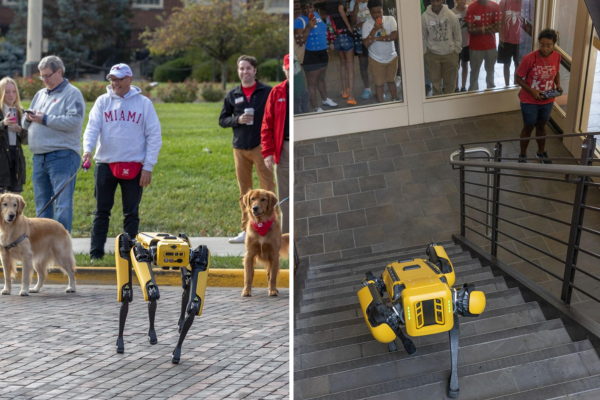
On left, Boston Dynamics Spot has a Homecoming Parade meet-up with Ivy and Newton, the official Miami University dogs, along with Miami University President Gregory Crawford. On right, it demonstrates its stair-climbing capabilities at a K-12 outreach event in Benton Hall.
SoftBank Robotics Pepper robots
Two SoftBank Robotics Pepper robots were purchased by the Department of Mechanical and Manufacturing Engineering in 2018 using RAPIDS 2 funds. The Pepper robots, designed for human interaction, have been used by nearly 100 students so far as part of courses such as MME 275 (Human-Robot Interaction) as well as capstone projects for students in the College of Creative Arts’ Emerging Technology and Business Design program.
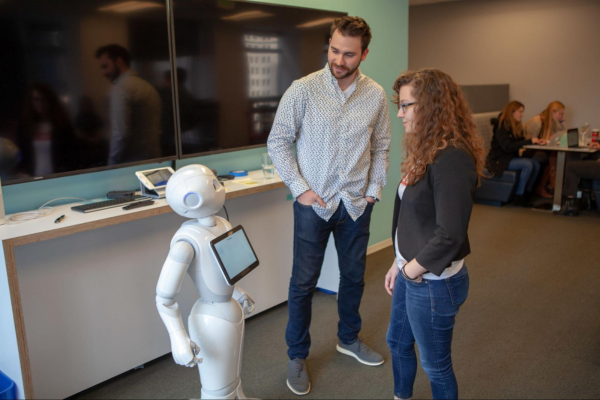
Miami students interact with a Pepper robot, purchased through RAPIDS 2 grant funding.
BioAssemblyBot 3D Printer
Miami’s Department of Chemical, Paper, and Biomedical Engineering (CPB) has utilized RAPIDS grant funding to purchase several pieces of equipment. Some of this equipment is currently in use in the Miami University Library makerspace system , as part of the RAPIDS funding agreement to ensure the technology is accessible to many users. Within CEC, the BioAssemblyBot 3D Printer has been used extensively by CEC students for projects and research as available technology within Professor (and Chair of CPB) Jessica Sparks’ research lab.
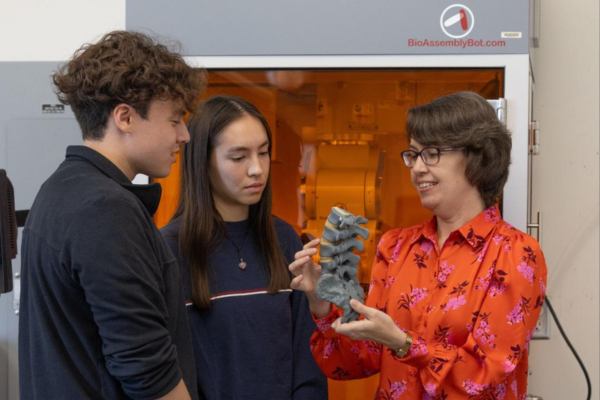
College of Engineering and Computing at Miami University is committed to providing engineering and computing students with hands-on learning experiences that equip them to enter the workforce immediately and thrive within it. Thanks to support from the state of Ohio's RAPIDS program, CEC has been able to modernize learning laboratories with the next generation technology our students need to understand in order to develop as leaders in their chosen career fields.